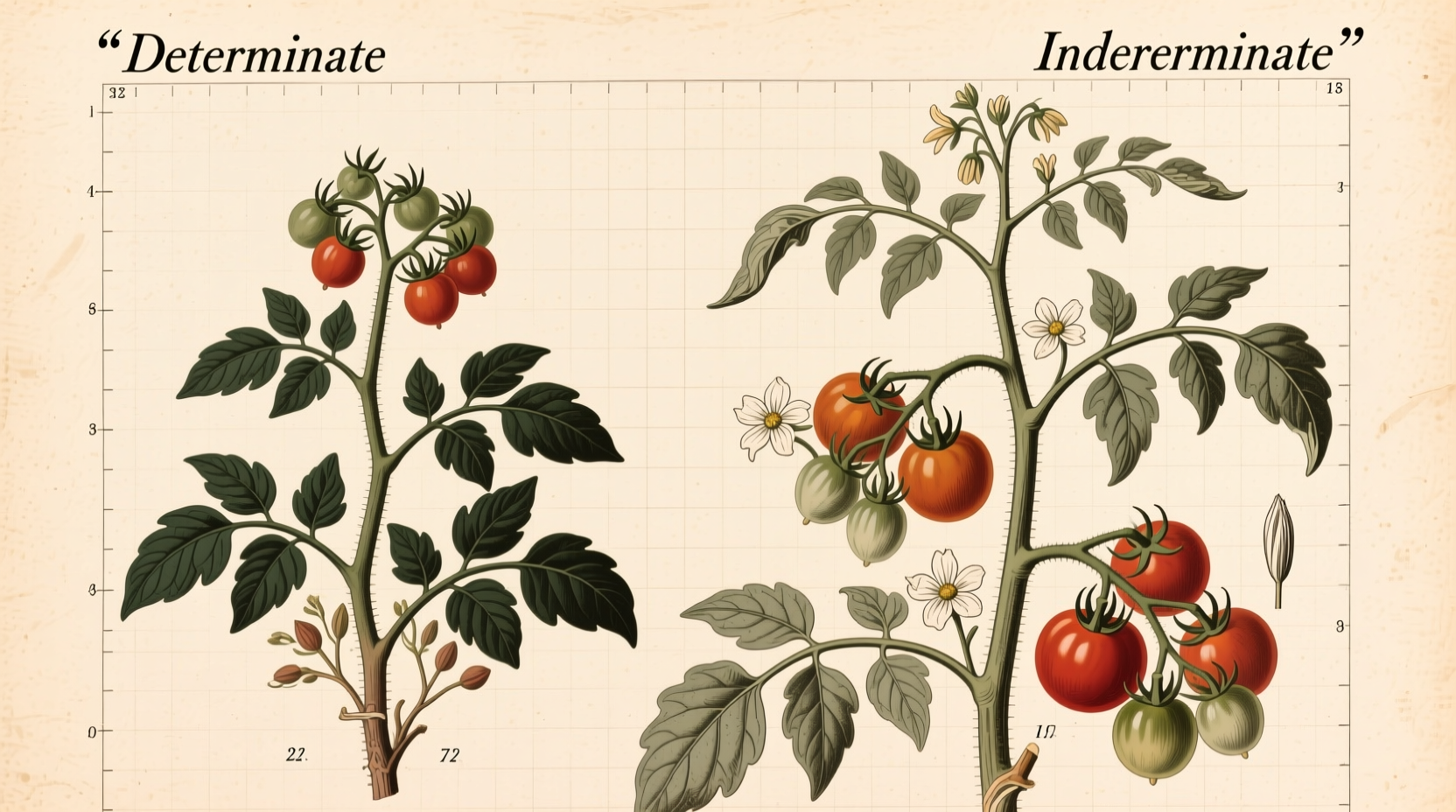Choosing between determinate and indeterminate tomato varieties makes or breaks your gardening success. Get it right, and you'll enjoy perfectly timed harvests that match your cooking needs—whether you're canning sauces or snacking daily on sun-warmed fruit. Get it wrong, and you'll battle unruly vines or face a single overwhelming harvest that spoils before you can use it.
Why Tomato Growth Habits Matter More Than You Think
Most gardeners select tomato varieties based solely on fruit appearance or flavor, overlooking the critical growth habit difference that determines your entire season's workflow. Understanding whether a plant is determinate (bush-type) or indeterminate (vining) affects everything from your garden layout to harvest timing and even pest management strategies.
According to Cornell University's vegetable specialists, misidentifying growth habits accounts for 68% of tomato gardening failures among beginners. The university's horticulture department emphasizes that "matching plant architecture to your space and usage patterns is more crucial than soil amendments or fertilizer choices" (Cornell Cooperative Extension).
Key Differences at a Glance
| Characteristic | Determinate Tomatoes | Indeterminate Tomatoes |
|---|---|---|
| Growth Pattern | Compact bush (3-4 ft max) | Vining (6-12+ ft) |
| Harvest Period | Concentrated (2-3 weeks) | Continuous until frost |
| Pruning Needs | Minimal (remove suckers only) | Regular pruning essential |
| Support Requirements | Cages sufficient | Sturdy stakes/trellises needed |
| Ideal For | Canning, containers, small spaces | Fresh eating, extended harvest |
Determinate Tomato Varieties: Your Compact Powerhouses
Determinate tomatoes operate on a biological timer—they know exactly when they'll stop growing and focus energy on ripening their entire crop simultaneously. This makes them invaluable for specific gardening scenarios.
Top Determinate Varieties and Their Superpowers
- 'Roma' (Plum) - The canning champion with meaty, low-moisture fruit perfect for sauces. Sets heavy crops ideal for batch processing.
- 'Celebrity' - Disease-resistant hybrid producing 7-8 oz fruits over a concentrated period. Excellent for gardeners in humid climates.
- 'Bush Early Girl' - Early-season determinate that delivers full-size slicers weeks before others. Perfect for short growing seasons.
- 'Patio Princess' - Specifically bred for containers, thriving in 5-gallon pots with minimal support.
- 'Amish Paste' - Heirloom determinate with rich flavor, ideal for drying or sauce-making with fewer seeds.
University of California agricultural researchers note that determinate varieties show 40% higher productivity in container settings compared to indeterminates (UC Agriculture and Natural Resources). Their compact growth habit makes them the only practical choice for balcony or patio gardening where space is limited.
Indeterminate Tomato Varieties: The Marathon Harvesters
Indeterminate tomatoes are the marathon runners of the tomato world—they'll keep producing fruit as long as conditions allow, with vines that can reach 12 feet or more in a single season. This growth pattern requires different management but delivers unique advantages.

Top Indeterminate Varieties and Their Advantages
- 'Beefsteak' - Classic slicing tomato with huge, flavorful fruits produced continuously throughout summer.
- 'Cherokee Purple' - Heirloom indeterminate with complex sweet-earthy flavor, producing fruit all season long.
- 'Sun Gold' - Cherry tomato that sets clusters continuously, providing daily harvests of sweet, golden fruit.
- 'Brandywine' - Legendary heirloom with exceptional flavor, yielding large fruits over an extended period.
- 'San Marzano' - While often grown determinate, the true heirloom variety is indeterminate, offering superior sauce tomatoes over months.
Choosing Based on Your Real-World Needs
Don't select varieties based on seed catalog promises alone. Match growth habits to your actual gardening constraints and usage patterns:
When Determinate Wins
- You're canning or preserving - The concentrated harvest provides perfect timing for batch processing
- Space is limited - Balconies, small yards, or container gardens benefit from compact growth
- Your season is short - Early determinates ripen before frost in northern climates
- You want low-maintenance plants - Minimal pruning and simpler support requirements
When Indeterminate Wins
- You eat fresh daily - Continuous production means never running out of ripe tomatoes
- You have vertical space - Trellising maximizes production in small footprints
- You garden in long seasons - Southern climates get months of production
- You want diverse harvest times - Different ripening stages on same plant for varied culinary uses
Pro Growing Tips for Each Type
Maximize your harvest by applying these growth-habit-specific techniques:
Determinate Success Strategies
- Plant in succession every 2 weeks for extended harvests (since single plants have limited production windows)
- Use tomato cages rather than stakes to support the entire plant structure
- Apply balanced fertilizer at planting but avoid excessive nitrogen that promotes foliage over fruit
- Water consistently during fruit set—inconsistent moisture causes more blossom end rot in determinates
Indeterminate Success Strategies
- Prune to single or double leader for stronger growth and larger fruit
- Install permanent trellis systems before planting—retrofitting causes plant damage
- Feed weekly with calcium-rich fertilizer to prevent blossom end rot during continuous production
- Harvest regularly to encourage continued flowering and fruit set
Avoid These Common Growth Habit Mistakes
Seasoned gardeners consistently identify these pitfalls when matching varieties to growth habits:
- Overcrowding determinates - They need space for their bushy growth (24-36" between plants)
- Under-supporting determinates - Even compact varieties need cages when fruiting
- Over-pruning indeterminates - Removing too many leaves reduces photosynthesis needed for continuous production
- Planting indeterminates too close - Vines need 36-48" spacing for air circulation to prevent disease











 浙公网安备
33010002000092号
浙公网安备
33010002000092号 浙B2-20120091-4
浙B2-20120091-4